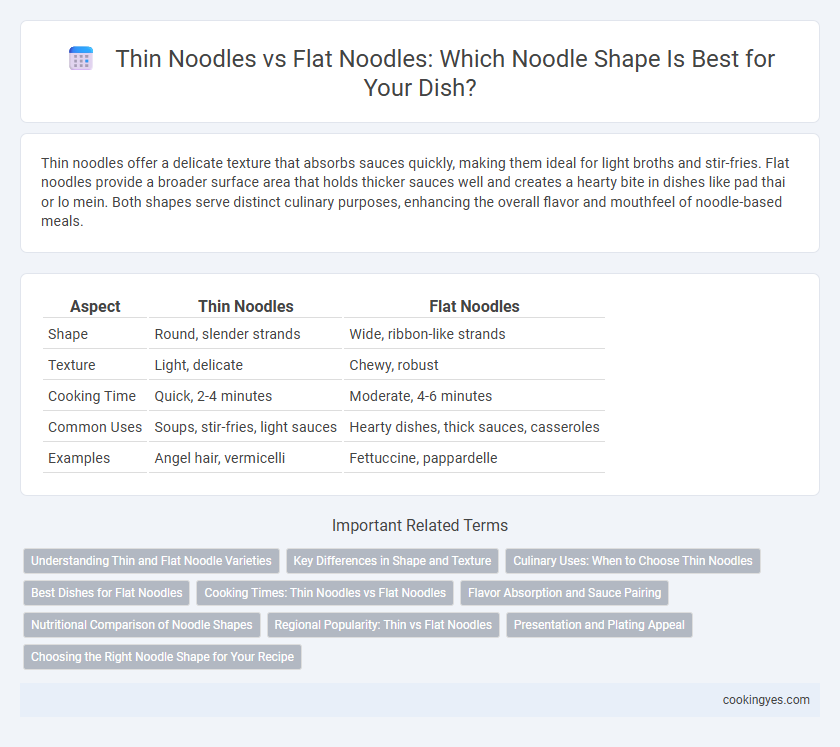Thin noodles offer a delicate texture that absorbs sauces quickly, making them ideal for light broths and stir-fries. Flat noodles provide a broader surface area that holds thicker sauces well and creates a hearty bite in dishes like pad thai or lo mein. Both shapes serve distinct culinary purposes, enhancing the overall flavor and mouthfeel of noodle-based meals.
Table of Comparison
| Aspect | Thin Noodles | Flat Noodles |
|---|---|---|
| Shape | Round, slender strands | Wide, ribbon-like strands |
| Texture | Light, delicate | Chewy, robust |
| Cooking Time | Quick, 2-4 minutes | Moderate, 4-6 minutes |
| Common Uses | Soups, stir-fries, light sauces | Hearty dishes, thick sauces, casseroles |
| Examples | Angel hair, vermicelli | Fettuccine, pappardelle |
Understanding Thin and Flat Noodle Varieties
Thin noodles, such as somen and vermicelli, are prized for their delicate texture and quick cooking time, making them ideal for light soups and stir-fries. Flat noodles, including fettuccine and wide rice noodles, offer a broader surface area that holds sauces well and provides a chewier bite, commonly used in hearty dishes like pad see ew and chow fun. Understanding these variations helps chefs select the perfect noodle shape to complement different cooking methods and flavor profiles.
Key Differences in Shape and Texture
Thin noodles are cylindrical and slender, offering a smooth texture that allows them to cook quickly and absorb light sauces effectively. Flat noodles feature a wider, ribbon-like shape, providing a chewier bite and a heartier mouthfeel ideal for thick, robust sauces or stir-fries. The distinct difference in thickness and width directly influences cooking time, sauce adherence, and overall eating experience in various Asian culinary dishes.
Culinary Uses: When to Choose Thin Noodles
Thin noodles excel in delicate dishes such as soups, stir-fries, and light Asian broths where their slender shape allows rapid cooking and smooth texture absorption. Their minimal surface area ensures they do not overwhelm subtle flavors, making them ideal for recipes requiring quick preparation or gentle handling. Choose thin noodles to achieve a tender bite and harmonious blend with fine, aromatic ingredients in dishes like ramen, pho, and pad thai.
Best Dishes for Flat Noodles
Flat noodles, known for their broad surface and chewy texture, are ideal for dishes like Pad See Ew, a popular Thai stir-fry featuring soy sauce, Chinese broccoli, and meat or tofu. Their wide shape allows them to absorb rich sauces effectively, making them perfect for hearty meals such as beef stroganoff or wide rice noodles in pho. Flat noodles also excel in cold dishes and salads, where their texture holds up well against dressings and fresh vegetables.
Cooking Times: Thin Noodles vs Flat Noodles
Thin noodles typically have shorter cooking times, often ranging from 2 to 4 minutes, due to their slender shape allowing heat to penetrate quickly. Flat noodles, being thicker and wider, generally require longer cooking times, approximately 5 to 7 minutes, to ensure even doneness throughout. Adjusting cooking times based on noodle shape ensures optimal texture and prevents overcooking or mushiness.
Flavor Absorption and Sauce Pairing
Thin noodles excel in flavor absorption due to their larger surface area relative to volume, allowing sauces to cling more effectively, making them ideal for light, broth-based dishes and delicate sauces such as soy or sesame. Flat noodles feature a broader surface that holds thicker, chunkier sauces like Alfredo or meat ragu, creating a more substantial bite and enhancing the overall mouthfeel of hearty recipes. Selecting noodle shape based on sauce texture optimizes taste integration and culinary experience.
Nutritional Comparison of Noodle Shapes
Thin noodles typically have a higher surface area to volume ratio, allowing for faster cooking and potentially lower glycemic index due to quicker starch gelatinization. Flat noodles, being thicker and wider, may retain more moisture and offer a slightly higher carbohydrate content per serving, impacting overall calorie intake. Nutritionally, both noodle shapes provide similar amounts of protein and fiber, but the choice may influence digestion speed and satiety levels depending on portion size and preparation method.
Regional Popularity: Thin vs Flat Noodles
Thin noodles dominate East Asian cuisines such as Japanese ramen and Vietnamese pho, prized for their quick cooking and ability to absorb broths. Flat noodles are more prevalent in Southeast Asian and Italian dishes, like Pad See Ew and fettuccine, valued for their broad surface that holds rich sauces. Regional preferences for noodle shapes often align with traditional cooking methods and local ingredient availability.
Presentation and Plating Appeal
Thin noodles create a delicate, refined look ideal for minimalist plating styles, enhancing texture visibility and allowing intricate garnishes to stand out. Flat noodles offer a broader surface area that catches and holds sauces effectively, adding vibrant color and visual richness to the dish. Choosing between thin and flat noodles directly impacts the visual balance and overall appeal of the presentation, influencing diner perception and appetite stimulation.
Choosing the Right Noodle Shape for Your Recipe
Thin noodles offer a delicate texture and cook quickly, ideal for soups and light stir-fries, enhancing broth absorption and flavor integration. Flat noodles provide a broader surface area, perfect for sauces and hearty dishes, delivering a satisfying chew and robust mouthfeel. Selecting the right noodle shape depends on the recipe's sauce consistency and desired texture to optimize taste and dining experience.
Thin noodles vs Flat noodles for noodle shape Infographic

 cookingyes.com
cookingyes.com